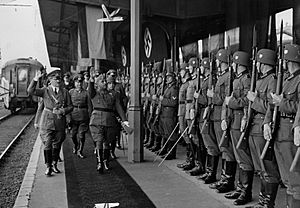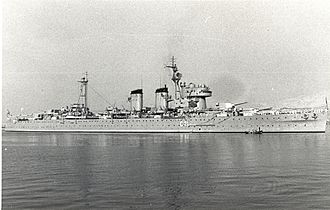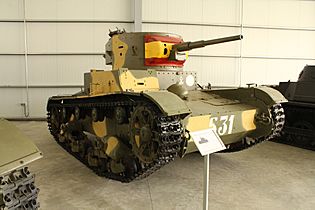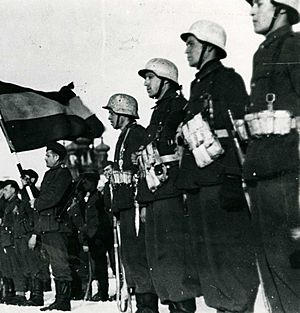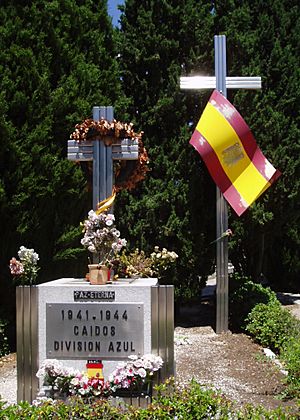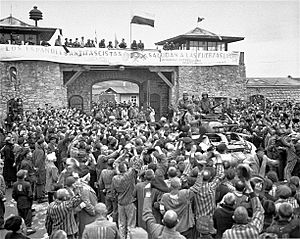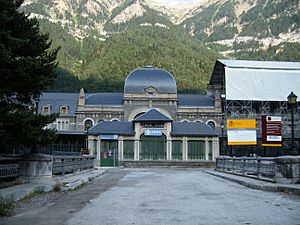Spain during World War II facts for kids
During World War II, Spain officially said it was neutral. This meant Spain would not pick a side in the war. However, this neutrality changed sometimes. After France fell to Germany in June 1940, Spain's policy became "non-belligerence." This meant Spain was not fighting, but it was leaning towards one side.
The Spanish leader, Francisco Franco, wrote to Adolf Hitler in June 1940. He offered to join the war if Hitler helped Spain expand its lands overseas. Later that year, Franco met Hitler in Hendaye, France. They talked about Spain possibly joining the Axis Powers (Germany and Italy). No agreement was made, but Franco still helped the Axis. Germany and Italy had supported Franco during the Spanish Civil War (1936–1939).
Even though Franco liked the Axis's ideas, he also placed his armies in the Pyrenees Mountains. This was to stop the Axis from invading Spain. Spain did not want to join the war fully because it needed supplies from the United States. Also, Spain was still recovering from its own civil war. Franco knew his army could not protect the Canary Islands or Spanish Morocco from a British attack.
In 1941, Franco let Spanish volunteers join the German army. They were only allowed to fight against the Soviet Union on the Eastern Front. This group was called the Blue Division. They fought from 1941 to 1944.
As the war started to turn against the Axis, Spain returned to "strict neutrality." In 1944, the United States pressured Spain to stop sending tungsten (a metal) to Germany and to bring the Blue Division home. The U.S. stopped sending oil to Spain, which forced Franco to agree. After the war, Spain was not allowed to join the new United Nations. This was because of its support for the Axis. Many countries isolated Spain until the mid-1950s.
Contents
Spain's Leaders During the War
During World War II, Spain had a government where one person, Franco, held all the power. Even though Franco liked the Axis and felt thankful to Benito Mussolini (Italy's leader) and Adolf Hitler, his government was split. Some officials liked Germany (Germanophiles), and others liked Britain (Anglophiles).
When the war began, Juan Beigbeder Atienza, who liked Britain, was the foreign minister. But when Germany won many battles, Franco replaced him. He chose Ramón Serrano Súñer, Franco's brother-in-law, who strongly liked Germany (October 1940). After the Allied forces won battles in North Africa in 1942, Franco changed his mind again. He replaced Serrano Súñer with Francisco Gómez-Jordana Sousa, who was pro-British, in September. Another important person who liked Britain was the Duke of Alba, Spain's ambassador in London.
Spain's Diplomatic Actions

From the start of World War II, Spain favored the Axis Powers. Besides sharing similar ideas, Spain owed Germany $212 million for military supplies during the Civil War. In June 1940, after France fell, Spain's ambassador in Berlin sent a note. In it, Franco said he was "ready to join the war on Germany and Italy's side" if certain things happened.
Franco decided to join the Axis in June 1940. To prepare his people, Spanish media started campaigns against Britain and France. They demanded French Morocco, Cameroon, and the return of Gibraltar. On June 19, 1940, Franco sent a message to Hitler saying he wanted to join the war. But Hitler was annoyed because Franco wanted the French colony of Cameroon. This land had been German before World War I, and Hitler planned to take it back.
At first, Hitler was not very interested in Franco's offer. He thought Germany would win easily. In August 1940, Hitler became serious about Spain joining the war. A big problem was Germany's demand for air and naval bases in Spanish Morocco and the Canary Islands. Franco completely disagreed with this. Hitler wanted these bases for a future naval war with the United States.
In September, after the Royal Air Force defeated the Luftwaffe in the Battle of Britain, Hitler promised Franco help. This was if Spain actively joined the war. Hitler promised that "Germany would do everything to help Spain." He also said Germany would recognize Spain's claims to French land in Morocco. In return, Germany wanted a share of Morocco's raw materials. Franco responded positively but did not make a firm promise. Spanish media pushed for Spain to reclaim parts of Catalonia and the Basque Country that were still under French control.
Hitler and Franco met only once in Hendaye, France, on October 23, 1940. They wanted to finalize an alliance. By this time, the benefits for both sides were less clear. Franco asked for too much from Hitler. To join Germany and Italy, Franco demanded strong defenses for the Canary Islands. He also wanted large amounts of grain, fuel, military vehicles, aircraft, and other weapons. Hitler responded by threatening Spain with a possible takeover of its land by Vichy France. In the end, they did not reach an agreement. A few days later, Hitler famously told Mussolini, "I prefer to have three or four of my own teeth pulled out than to speak to that man again!"
Historians still debate if Franco asked for too much on purpose. Maybe he set the price for his alliance so high that Hitler would refuse. This would save Spain from another terrible war.
The UK and the US used money to keep Spain neutral in 1940. Spain needed oil from the United States. The U.S. agreed to listen to Britain's advice on this. Spain was told that oil supplies would be limited. Spain did not have a strong navy, so if it joined the war, it would need Germany to supply oil. Germany itself relied on captured French oil, so Spain's extra needs were not helpful.
In December 1940, Hitler contacted Franco again. He sent a letter asking for German troops to pass through Spain to attack Gibraltar. Franco refused. He said Britain still posed a danger to Spain and its colonies. Franco told Hitler he wanted to wait until Britain "was about to collapse." In a second letter, Hitler offered grain and military supplies to Spain. But by this time, Italian troops were losing to the British in Africa. The UK was clearly not defeated. Franco replied that the situation had changed a lot since October.
At Hitler's request, Franco also met with Italian leader Benito Mussolini in Italy on February 12, 1941. Hitler hoped Mussolini could convince Franco to join the war. However, Mussolini was not interested in Franco's help. His forces had recently suffered many defeats.
Franco signed the Anti-Comintern Pact in November 1941. This was an agreement against communism. In 1942, the Allies planned Operation Torch, landings in North Africa. They worried Spain might join the Axis and close the Straits of Gibraltar. To prevent this, they planned a landing in Casablanca. This would allow an overland route that bypassed the Straits.
After the war, Franco's government gave a pension to the widow of Admiral Wilhelm Canaris. Canaris had advised Franco to keep Spain out of the war. Franco was always grateful for this advice.
Franco's support for the Axis led to Spain being isolated after the war. Trade with most countries stopped. U.S. President Franklin D. Roosevelt, who had promised Spain would not suffer, died in April 1945. His successor, Harry S. Truman, and other Allied governments were less friendly. Many nations pulled their ambassadors from Spain. Spain was not allowed into the United Nations until 1955.
Spain's Military During the War
Even though Spain tried to avoid fighting, it made plans to defend itself. At first, most of the Spanish Army was in southern Spain. This was in case the Allies attacked from Gibraltar in 1940 and 1941. But as the Axis became more interested in Gibraltar, Franco moved his troops. He gradually sent them to the Pyrenees Mountains along the French border. This was in case Germany tried to invade Spain. By the time it was clear the Allies were winning, Franco had all his troops on the French border. He received promises from Allied leaders that they would not invade Spain.
Spanish Armed Forces Overview
At the end of the Spanish Civil War in April 1939, Spain reorganized its military. The Army, Navy, and Air Force each got their own ministries. The country was divided into military regions. In 1943, a new military region and the First Armored Division were created.
After the Civil War, the Spanish Army had over 1 million men. But Franco quickly reduced it to 250,000 in early 1940. Most soldiers were conscripts serving two years.
Concerns about the war and possible invasion made Franco increase the army's size again. In November 1942, Allied landings in North Africa and German occupation of France brought the war closer. Franco ordered a partial mobilization, bringing the army to over 750,000 men. The Spanish Air Force and Spanish Navy also grew. By 1945, there were 35,000 airmen and 25,000 sailors.
During World War II, the Army in Spain had eight Army Corps. Each had two or three Infantry Divisions. The Army in North Africa had two Army Corps. There were also commands for the Canary and Balearic Islands, a Cavalry Division, and Artillery reserves.
The Spanish Army was used to fighting in fixed positions. It lacked the fast movement of armored units seen in other European armies. It also lacked experience with combined tank and infantry operations. The most modern tanks from the Civil War, like the Russian T-26 and German Panzer I, were already old by 1940.
Of the Spanish Navy's six cruisers, only four could be used. The flagship was the heavy cruiser Canarias. The Air Force had hundreds of fighters, mainly from Italy or Germany. These included the Fiat C.R.32 and Messerschmitt Bf 109. Bombers included the SM.79 and Heinkel He 111. Spain also had Soviet-made aircraft from the Civil War.
By the end of World War II in 1945, the Spanish Army had 300,000 enlisted men. Their weapons were very old. This was because Allied and Axis armies had developed much newer technology during the war.
- Some pictures of Spanish Armed Forces of that time
-
T-26, the most powerful and numerous tank of the Spanish Army at the time.
German Plans to Invade Gibraltar
Before Franco and Hitler's meeting in October 1940, Spain and Germany had planned an attack on Gibraltar. Gibraltar was a British territory and military base. It was important for controlling the western exit from the Mediterranean Sea. Germany also understood how important North-West Africa was for bases.
This plan was called Operation Felix. It was very detailed before the talks failed at Hendaye. By March 1941, Germany was preparing for its invasion of the Soviet Union. An updated plan, Felix-Heinrich, would be used after goals in Russia were met. But these goals were not met, and Franco still did not join the war.
After the war, German Field Marshal Wilhelm Keitel said: "Instead of attacking Russia, we should have strangled the British Empire by closing the Mediterranean. The first step... would have been the conquest of Gibraltar."
German Submarine Supplies
German submarines were supplied in Spanish ports between January 1940 and February 1944. There were 25 or 26 documented cases. Most were planned operations, and three were emergencies. The ports used were Vigo, Las Palmas, Cádiz, and El Ferrol. They received fuel, lubricants, water, food, and sometimes torpedoes. Injured sailors were also taken off the ships. Most operations happened overnight. Four German supply ships were involved.
Occupation of Tangier
Spanish troops took over the Tangier International Zone on June 14, 1940. This was the same day Paris fell to the Germans. Franco's government said this was a temporary wartime measure. In November 1940, Spain ended the city's international setup. This caused a dispute with Britain. Spain then promised not to build defenses in the area. In May 1944, Franco expelled all German diplomats from Tangier.
The territory returned to its pre-war status on October 11, 1945. Tangier joined the rest of Morocco when it became fully independent in 1956.
Volunteers in the War
Spain's main involvement in the war was through volunteers. They fought for both sides, often based on their loyalties from the Spanish Civil War.
Spanish Volunteers for the Axis
Franco did not bring Spain into World War II on the Axis side. However, he allowed volunteers to join the German Army. The clear condition was that they would only fight against Soviet Communism on the Eastern Front. They would not fight against the western Allies. This way, Spain could stay peaceful with the western Allies. It also repaid Germany for its help in the Spanish Civil War. And it gave a way for many Spanish nationalists to show their strong anti-Communist feelings.
Hitler approved the use of Spanish volunteers on June 24, 1941. Many volunteers signed up across Spain. Cadets from the officer training school in Zaragoza volunteered in large numbers. Spain first planned to send about 4,000 men. But soon, there were enough volunteers for a whole division. This was the Blue Division, or División Azul. It had 18,104 men, including an air force squadron called the Blue Squadron.
The Blue Division trained in Germany. Then it served in the Siege of Leningrad. They notably fought at the Battle of Krasny Bor. There, 6,000 Spanish soldiers pushed back about 30,000 Soviet troops. In October 1943, Spain was under strong diplomatic pressure. The Blue Division was ordered home, leaving a small group until March 1944. In total, about 45,000 Spaniards volunteered and served on the Eastern Front. Around 4,500 of them died.
372 members of the Blue Division were captured by the Red Army. 286 of these men were held until April 2, 1954. They returned to Spain on a ship provided by the International Red Cross.
Spanish Volunteers for the Allies
After losing the Spanish Civil War, many Republican soldiers and civilians went to France. The French government put them in refugee camps. To improve their lives, many joined the French Foreign Legion at the start of World War II. They made up a large part of it. About 60,000 joined the French Resistance, mostly as guerrillas. Several thousand more joined the Free French Forces and fought the Axis. Some sources say up to 2,000 served in General Leclerc's Second French Division.
The 9th Armoured Company was almost entirely made up of experienced Spanish veterans. It was the first Allied military unit to enter Paris when it was freed in August 1944. There, they met Spanish resistance fighters. Also, 1,000 Spanish Republicans served in the 13th Demi-Brigade of the Foreign Legion.
In Eastern Europe, the Soviet Union welcomed former Communist Spanish leaders and children from Republican families. When Germany invaded the Soviet Union in 1941, many, like Communist General Enrique Líster, joined the Red Army. About 700 Spanish Republicans served in the Red Army. Another 700 worked as partisans behind German lines. Some individual Spaniards, like the double-agent Juan Pujol García, also worked for the Allied side.
Bribes from Britain
According to a 2008 book, Winston Churchill allowed millions of dollars in bribes to Spanish generals. This was to try and stop General Franco from joining Germany in the war. In May 2013, files were released showing that MI6 (British intelligence) spent the modern equivalent of over $200 million. They bribed senior Spanish military officers, ship owners, and other agents. This was to keep Spain out of the war.
Resources and Trade
Even though Spain lacked money, oil, and other supplies, Franco's Spain provided some important materials to Germany. There were secret trade agreements between the two countries during the war. The main resource was wolfram (or tungsten) ore. This came from German-owned mines in Spain. Tungsten was vital for Germany's advanced engineering and weapon production. The Allies tried to buy all available supplies, and prices went very high. They also used diplomacy to influence Spain. But supplies to Germany continued until August 1944.
Payment for wolfram was used to pay off Spain's debt to Germany. Other minerals included iron ore, zinc, lead, and mercury. Spain also helped move goods from South America, like industrial diamonds. After the war, evidence showed large gold transactions between Germany and Spain. These stopped only in May 1945. It was believed this gold came from Nazi looting of occupied lands.
Spying and Sabotage
As long as Spain allowed it, the Abwehr (Germany's intelligence group) could work in Spain and Spanish Morocco. They often cooperated with Franco's government. Gibraltar's military sites were a main target for sabotage. They used Spanish workers who were against Britain. One attack happened in June 1943. A bomb caused a fire and explosions in the dockyard. The British later became more successful. They used agents who had switched sides and friendly anti-Fascist Spaniards to find out about future attacks. A total of 43 sabotage attempts were stopped this way. By January 1944, a Gibraltarian and two Spanish workers were executed for trying to commit sabotage.
The Abwehr also paid, trained, and equipped saboteurs to attack British naval ships. German agents contacted a Spanish army officer, Lieutenant Colonel Eleuterio Sánchez Rubio. He was a member of the Falange party and coordinated intelligence in the area. He helped set up a network of saboteurs who could get into Gibraltar. Spanish agents sank one armed trawler and destroyed another ship. This caused the deaths of six British sailors in January 1942.
The Abwehr also had observation posts along both sides of the Straits of Gibraltar. They reported on ship movements. A German agent in Cádiz was part of a successful Allied trick called Operation Mincemeat before the invasion of Sicily in 1943. In early 1944, the situation changed. The Allies were clearly winning. A double agent gave enough information for Britain to protest to the Spanish government. As a result, Spain declared its "strict neutrality." The Abwehr's operations in southern Spain were then shut down. The train station of Canfranc was used to smuggle people and information from Vichy France to the British consulate in San Sebastián.
Jews and Other Refugees
In the first years of the war, Spain had rules for refugees, but they were mostly ignored. Refugees were mainly from Western Europe. They were fleeing being sent to concentration camps from occupied France. There were also Jews from Eastern Europe, especially Hungary.
Throughout World War II, Spanish diplomats working for Franco's government protected Eastern European Jews, especially in Hungary. Jews who said they had Spanish ancestors were given Spanish documents. They did not have to prove their case. They either left for Spain or survived the war with their new legal status in occupied countries.
As the war started to turn, and Francisco Gómez-Jordana Sousa became Spain's foreign minister, Spanish diplomacy became "more sympathetic to Jews." Around that time, Spanish doctors in Poland learned about the Nazi extermination plans. When they returned home, they told Admiral Luís Carrero Blanco, who then told Franco.
Diplomats talked about Spain being a route to a camp for Jewish refugees near Casablanca. But this did not happen without support from the Free French and British. Still, control of the Spanish border with France became a bit looser. Thousands of Jews managed to cross into Spain, many by secret routes. Almost all of them survived the war. The American Jewish Joint Distribution Committee worked openly in Barcelona.
Soon after, Spain started giving citizenship to Sephardic Jews in Greece, Hungary, Bulgaria, and Romania. Many Ashkenazic Jews also managed to be included, as did some non-Jews. The Spanish head of mission in Budapest, Ángel Sanz Briz, saved thousands of Ashkenazim in Hungary. He gave them Spanish citizenship, put them in safe houses, and taught them a little Spanish. This way, they could pretend to be Sephardim.
Toward the war's end, Sanz Briz had to flee Budapest. This left these Jews open to arrest. An Italian diplomat, Giorgio Perlasca, who was under Spanish protection, used fake documents. He convinced Hungarian authorities that he was the new Spanish Ambassador. He continued Spanish protection of Hungarian Jews until the Red Army arrived.
Spain did more to help Jews escape concentration camps than most neutral countries. But there has been debate about Spain's attitude towards refugees. Franco's government did not seem to share the strong anti-Jewish ideas promoted by the Nazis. About 25,000 to 35,000 refugees, mostly Jews, were allowed to pass through Spain to Portugal and beyond.
After the war, Franco's government was friendly to those who had been responsible for sending Jews to camps. This included Louis Darquier de Pellepoix from the Vichy Régime in France. It also included many former Nazis like Otto Skorzeny and Léon Degrelle.
José Finat y Escrivá de Romaní, Franco's chief of security, issued an order on May 13, 1941. He asked all provincial governors for a list of all Jews in their areas. After the list of 6,000 names was made, Romaní became Spain's ambassador to Germany. This allowed him to give the list personally to Heinrich Himmler. After Germany's defeat in 1945, the Spanish government tried to destroy all evidence of cooperation with the Nazis. But this official order survived.
Images for kids
-
Memorial to the Spanish immigrants to France who fought in the Spanish Civil War, and in the French Resistance. Garden of the Rights of the Child, Saint-Denis
See also
- List of Spanish military equipment of World War II
- Spanish Maquis
- Neutral powers during World War II
- Spain during World War I


